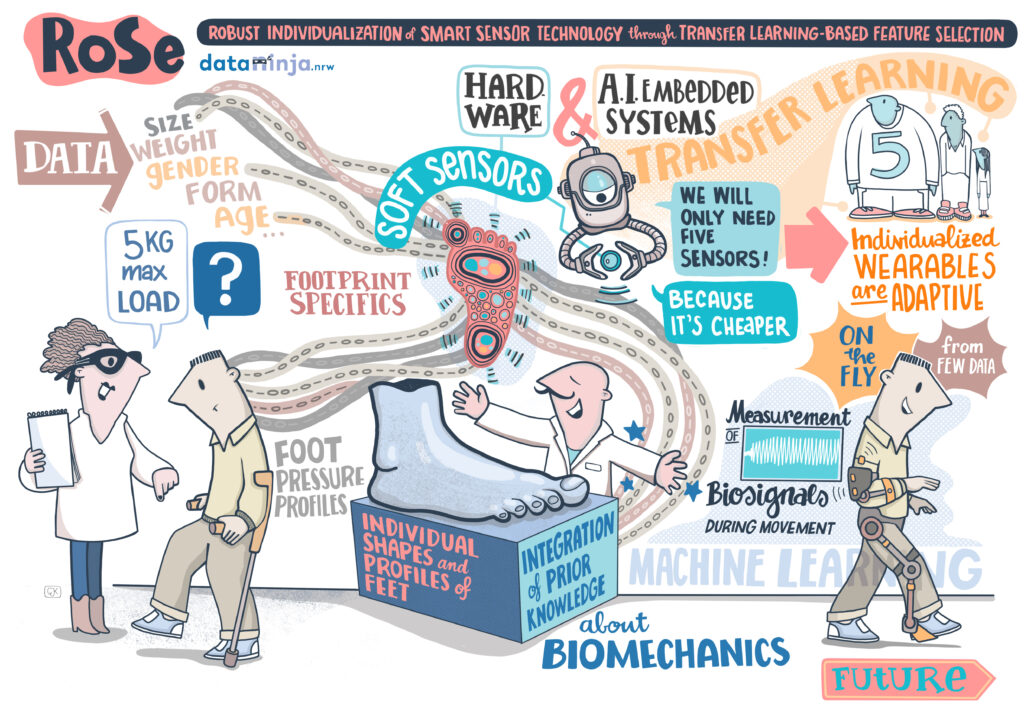Goal
The increasing availability of small, precise and easy-to-integrate sensors for measuring different physical quantities allows their use in innovative support systems such as wearables in healthcare and medical technology. The meaningful application of many such sensors requires advanced AI-based evaluation approaches to robustly extract meaningful information from the sensor population of a given support system. This challenge meets the requirements that the aforementioned support systems adapt individually to their users (batch size 1) and that this adaptation is done as far as possible on the algorithmic (AI-) and not on the hardware side. Conversely, this means that the embedded sensor population is chosen in such a way that its distribution is basically suitable for as many users as possible and that the number of individual sensors is restricted in a sensible way. The goal of the project is therefore to design methods that allow the optimization of hardware and AI components of smart sensors under the aspect of robust and efficient individualization.

Project Overview
This project focuses on two scenarios as examples. The first scenario (see illustration above) is directed to novel insoles that are inserted into shoes, for example, in the context of rehabilitation after injury and surgery of the lower extremities and continuously determine the leg load (pressure profile of the foot). Challenges in terms of individualization are weight, body size, foot shape, gait, etc.
The second scenario focuses on the prediction of limb movements based on biosignal measurements (sEMGs) on such muscles that actuate the limbs. Challenges in terms of individualization include electrode placement, body or limb dimensions, loading situations, etc.
The approach uses transfer learning-based feature selection methods- that is, novel feature selection technologies, which optimize the data representation such that it is best suitable for a subsequent individualization by means of software for ALL human partners- and combines them with domain knowledge from biomechanics and biosignal processing. In this way, both AI algorithms in the sense of black-box approaches and hybrid algorithms in the sense of AI-based grey- or white-box approaches can be designed.
1–4
Current Work
Scenario 1: Insoles
As a basis for experiments, we have recorded a dataset from 16 people walking over and standing/balancing on a high-resolution pressure sensor-mat. This amounts to thousands of image-like foot pressure profiles. When comparing the steps (stance phase) from two individuals, many differences already become apparent from visual inspection:


Even two steps from the same person may differ a lot, e.g. depending on whether the weight is put more on the inner or outer side of the foot. As our goal is to determine the leg load (the weight put on the foot), pressure sensors have to be integrated into the insole. However, considering the difference in pressure profiles, it is unclear where these sensors should be placed to get a precise estimate of the leg load. While the insole should be the same for everyone, the way the leg load is computed from the sensor readings (model parameters) may be adapted for each person. Given these constraints, we will use this dataset to evaluate methods which compute the optimal positioning of the pressure sensors in the future.
Scenario 2: Limb movement prediction
In the second scenario, the performance of different mathematical and biological features of sEMG signals was investigated. Furthermore, parameters of segmentation (segment length, offset for prediction) were varied and also compared. The best performing ones were then compared with time constants of the biological model. These investigations were carried out in a bachelor thesis and published in [Leserri et al., 2022].
Project Publications
- Grimmelsmann, Nils, Malte Mechtenberg, Wolfram Schenck, Hanno Gerd Meyer, and Axel Schneider (Aug. 2023). ‘‘sEMG-based prediction of human forearm movements utilizing a biomechanical model based on individual anatomical/ physiological measures and a reduced set of optimization parameters’’. In: PLOS ONE 18.8, pp. 1–28. doi:10.1371/journal.pone.0289549. url: https://doi.org/10.1371/journal.pone.0289549.
- Grimmelsmann, Nils, Malte Mechtenberg, Markus Vieth, Barbara Hammer, and Axel Schneider (2024). ‘‘Prediction of Intermuscular Co-contraction Based on the sEMG of Only One Muscle With the Same Biomechanical Direction of Action’’. en. In: DataNinja sAIOnARA Conference, pp. 47–49. doi: 10.11576/DATANINJA-1168. url: https://biecoll.ub.uni-bielefeld.de/index.php/dataninja/article/view/1168.
- Grimmelsmann, Nils, Malte Mechtenberg, Markus Vieth, Alexander Schulz, Barbara Hammer, and Axel Schneider (2024). ‘‘Predicting the Level of Co-Activation of One Muscle Head from the Other Muscle Head of the Biceps Brachii Muscle by Linear Regression and Shallow Feedforward Neural Networks.’’ In: In Proceedings of the 17th International Joint Conference on Biomedical Engineering Systems and Technologies (BIOSTEC 2024).
- Leserri, David, Nils Grimmelsmann, Malte Mechtenberg, Hanno Gerd Meyer, and Axel Schneider (Mar. 2022). ‘‘Evaluation of sEMG Signal Features and Segmentation Parameters for Limb Movement Prediction Using a Feedforward Neural Network’’. In: Mathematics 10.6, p. 932. issn: 2227-7390. doi: 10.3390/math10060932. url: http://dx.doi.org/10.3390/math10060932.
- Vieth, Markus (2024). ‘‘Nonlinear Prediction in a Smart Shoe Insole’’. en. In: DataNinja sAIOnARA Conference, pp. 50–52. doi: 10.11576/dataninja-1169. url: https://biecoll.ub.uni-bielefeld.de/index.php/dataninja/article/view/1169.
- Vieth, Markus, Nils Grimmelsmann, Axel Schneider, and Barbara Hammer (2022). ‘‘Efficient Sensor Selection for Individualized Prediction Based on Biosignals’’. In: Intelligent Data Engineering and Automated Learning — IDEAL 2022. Ed. by Hujun Yin, David Camacho, and Peter Tino. Cham: Springer International Publishing, pp. 326–337. isbn: 978-3-031-217531.
- Vieth, Markus, Nils Grimmelsmann, Axel Schneider, and Barbara Hammer (2024). ‘‘Similarity-Based Zero-Shot Domain Adaptation for Wearables’’. In: ESANN 2024 Proceedings. Bruges (Belgium) and online event. doi:10.14428/esann/2024.ES2024-123.
- Vieth, Markus, Alexander Schulz, and Barbara Hammer (2023). ‘‘Extending Drift Detection Methods to Identify When Exactly the Change Happened’’. In: Advances in Computational Intelligence. Ed. by Ignacio Rojas, Gonzalo Joya, and Andreu Catala. Cham: Springer Nature Switzerland, pp. 92–104. isbn: 978-3-031-43085-5.
Cooperation
References
- 1.Wolf-Homeyer S, Engelmann J, Schneider A. Application of reduced sensor movement sequences as a precursor for search area partitioning and a selection of discrete EEV-contour-ring fragments for active electrolocation. Bioinspiration & Biomimetics. 2018;13. doi:10.1088/1748-3190/aae23f
- 2.Prahm C, Schulz A, Paaßen B, et al. Counteracting Electrode Shifts in Upper-Limb Prosthesis Control via Transfer Learning. IEEE Transactions on Neural Systems and Rehabilitation Engineering. Published online March 2019. doi:10.1109/TNSRE.2019.2907200
- 3.Pfannschmidt L, Jakob J, Hinder F, Biehl M, Tino P, Hammer B. Feature relevance determination for ordinal regression in the context of feature redundancies and privileged information. Neurocomputing. 2020;416:266-279. doi:https://doi.org/10.1016/j.neucom.2019.12.133
- 4.Basa D, Schneider A. Learning point-to-point movements on an elastic limb using dynamic movement primitives. Robotics and Autonomous Systems. 2015;66:55-63. doi:https://doi.org/10.1016/j.robot.2014.12.011


